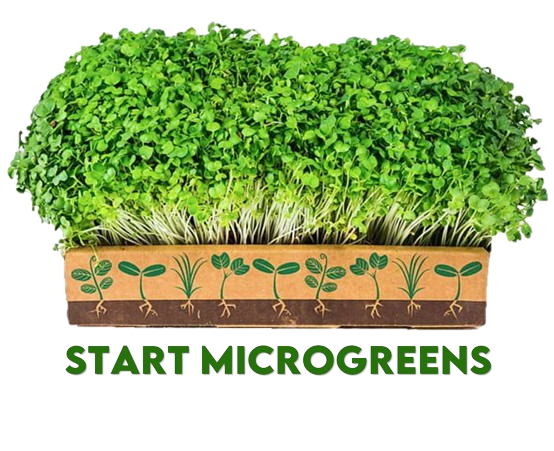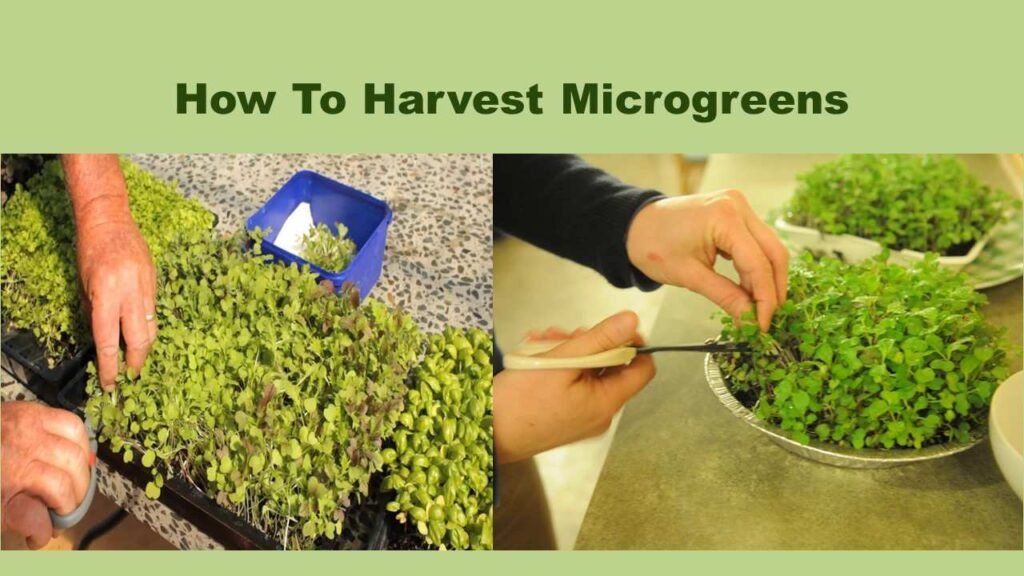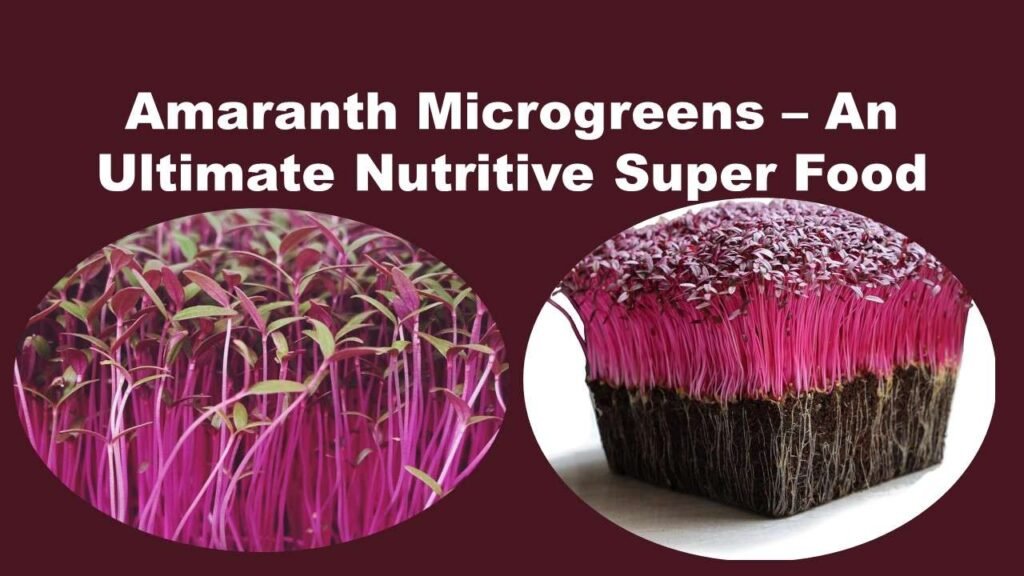How to Grow Microgreen Cilantro: Easy Pissy Guide for You
Microgreens are young and tender vegetable greens that get picked shortly after the first leaves, known as cotyledons, emerge during germination. Usually, they are harvested when the plants reach a height of 1 to 3 inches. Microgreens are smaller than baby greens but larger than sprouts and are prized for their strong flavors, vivid colors, and concentrated nutritional value. Microgreen cilantro is not just for its culinary purpose but also for their potential health benefits, as they are packed with vitamins, minerals, and antioxidants. Growing microgreens at home is relatively easy, making them a popular choice for home gardeners.
Overview of Microgreen Cilantro:
Cilantro, or coriander in certain regions, is a fragrant herb with green, finely divided leaves, belonging to the Apiaceae family. Widely used globally, both its leaves and seeds are edible with distinct flavors. The leaves of cilantro are commonly used in soups, and in adding a distinct flavor in dals and curries specially in north India. The leaves of cilantro contain antioxidants and vitamins which help in the improvement of human health. Also its seeds are used in culinary purposes as it has a warm flavor and used in different spice powders.
Culinary Uses:
| Culinary Use | Description |
| Garnish | Fresh leaves are added in small pieces in dals and curries |
| Seasoning | Adds a fresh, citrusy flavor to dishes such as salsas, guacamole, and marinades. |
| Salads | Mixed in green salads, mainly in raw cabbage |
| Sauces | Used in sauces like chimichurri and pesto for a burst of herbal brightness. |
Nutritional Benefits:
Cilantro, a herb used worldwide, is full of good things for your health. As it contains important vitamins and antioxidants that promote immunity in the body. Important minerals like potassium, calcium, and iron are in cilantro too, which are good for your heart, bones, and blood. Cilantro also has antioxidants and essential oils that might fight germs and help detoxify your body. With extra fiber and chlorophyll, cilantro not only makes food taste better but also gives you a mix of different nutrients.
| Nutrient | Nutritional Importance of Microgreen Cilantro |
| Vitamins | 1. Rich in Vitamin A, important for vision, immune function, and skin health. 2. Contains vitamin C, an antioxidant that supports immune function. 3. Good source of vitamin K, essential for blood clotting and bone health. |
| Minerals | Contains essential minerals like potassium, manganese, and iron. |
| Chlorophy ll | Contains chlorophyll, which may have detoxifying and antioxidant properties. |
| Dietary Fiber | Provides dietary fiber, which supports digestive health. |
| Essential Oils | Contains essential oils with potential antimicrobial properties. |
How to Approach for Microgreen Cilantro:
Plan your commercial microgreen cultivation space carefully, considering factors like lighting, temperature, and ventilation. Opt for indoor spaces with controlled environments for year-round production. Acquire high-quality cilantro seeds suitable for microgreen cultivation, ensuring they are untreated and safe for consumption. Sow cilantro seeds densely for even coverage, employing a watering system such as drip irrigation to ensure consistent moisture distribution. Maintain controlled temperatures, grow lights providing sufficient illumination, adjusting the duration based on the growth stage. Manage humidity to prevent mold, maintain proper ventilation, and monitor the growth regularly, adjusting conditions as needed. Harvest microgreens when they reach 1 to 3 inches, using sanitized tools, and package them appropriately for storage.
Steps in Growing microgreen cilantro:
To grow cilantro microgreens, gather cilantro seeds, soil, trays, and water. Fill a tray with soil, spread cilantro seeds evenly, and press them gently. Cover the tray with a clear lid or plastic wrap, and put it in a warm, dark spot for 2-3 days until you see sprouts. Then, move the tray to a place with indirect sunlight or under lights, giving them 12-16 hours of light daily while spraying water for humidity. Harvest the microgreens after 10-14 days when the first leaves fully develop, using scissors or a knife. Wash them under cool water, dry gently, and store in the fridge.
Pre-requirements:
Before you start growing cilantro microgreens, make sure you have the essentials ready. You’ll need cilantro seeds, a growing medium (either soil or a soilless mix), a tray or container, and water. These basic requirements set the foundation for a successful microgreen cultivation process. With these in place, you can proceed to fill the tray with the chosen growing medium, sow the cilantro seeds, and begin the journey of nurturing vibrant and flavorful cilantro microgreens.
Important Varieties and their Characteristics:
| Variety | Characteristics | Common Traits |
| Slow-Bolting (Leisure) | Slow-bolting; extended harvest period; traditional cilantro flavor | Vigorous growth |
| Santo | Vigorous growth; continuous supply; traditional cilantro flavor | Widely grown |
| Delfino (Cilantro Fernleaf) | Feathery, finely-cut leaves; unique appearance; strong cilantro flavor | Ornamental value |
| Jantar | Resistance to bolting; thrives in warmer temperatures; flavorful green leaves | Well-suited for warmer climates |
| Calypso | Aromatic leaves; robust cilantro taste; popular for culinary and ornamental use | Strong cilantro aroma |
| Long Standing | Long-lasting fresh leaves; continuous harvest | Reliable for sustained harvesting |
| Cruiser | Compact variety; suitable for containers; flavorful leaves for culinary use | Ideal for small-space gardening |
Seed Sowing:
When it comes to sowing cilantro seeds for microgreen cultivation, start by filling a tray with your chosen growing medium, whether it’s soil or a soilless mix. Ensure an even distribution by sprinkling cilantro seeds across the surface of the medium. Gently press the seeds into the growing medium, providing optimal contact for germination.
Germination:
For germination, cover the tray with a clear lid or plastic wrap. Put it in a warm, dark spot. After 2-3 days, check for the first signs of sprouts. This simple process promotes seeds to start growing into cilantro microgreens.
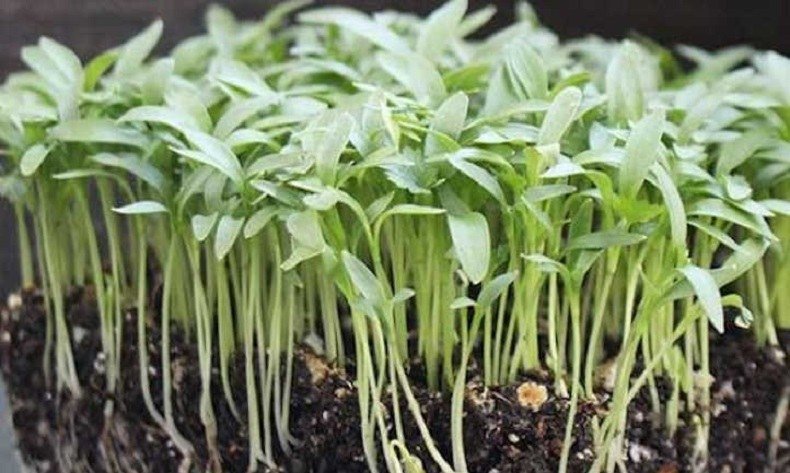
Image Source: epicgardening
Light:
Once your cilantro microgreens start sprouting, shift the tray to a spot with indirect sunlight or place it under lights. Make sure they get 12-16 hours of light every day. Keep misting them to maintain the right humidity levels. This step is very important in reference to good growth of greens.
Watering and Care:
To care for your cilantro microgreens, water them regularly to keep the soil damp. Ensure good airflow to prevent mold, and be cautious not to overwater. Keep an eye on humidity levels in the growing environment. By checking all these things the good development of cilantro is ensured.
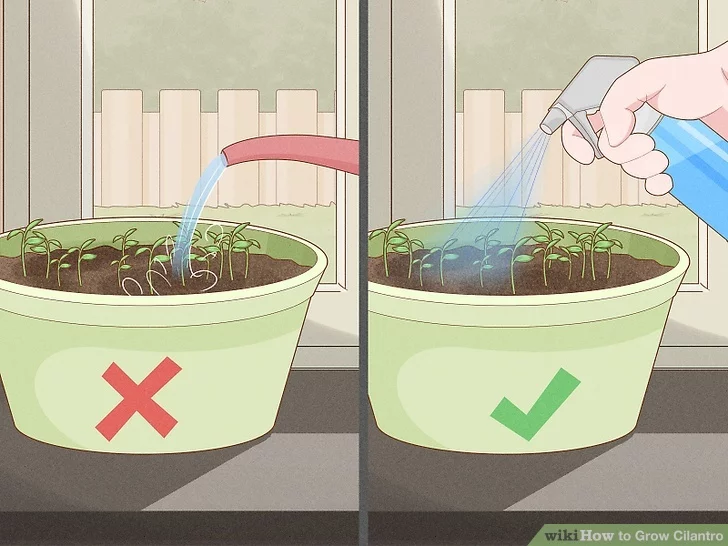
Image Source: wikiHow
Harvesting:
The harvesting phase for cilantro microgreens typically takes about 10 to 14 days. When the cotyledon leaves have fully developed, it is time for harvest. Utilize either scissors or a knife to carefully cut the microgreens slightly above the soil line. By ensuring proper time for harvesting and harvesting without damage and bruising one can get the greens with full texture and flavor.
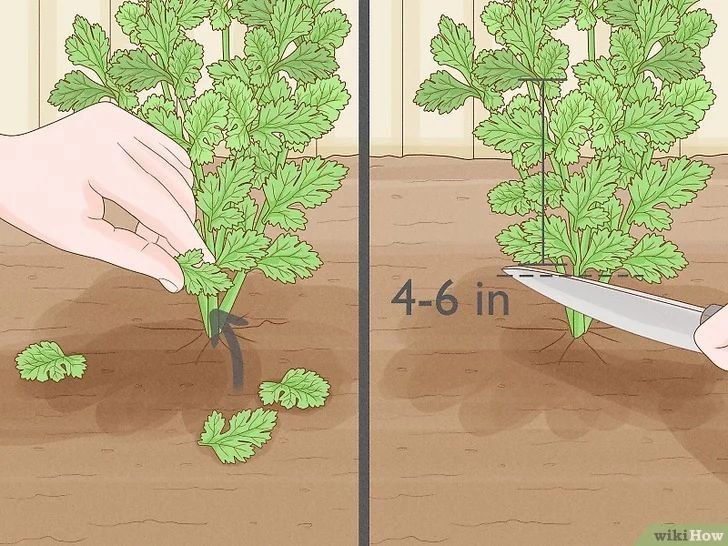
Image Source: wikiHow
Summary of Steps Involved in growing microgreen cilantro:
| Steps | Details |
| Pre-requirements | Cilantro seeds- Growing medium (soil or soilless mix)- Tray or container- Water |
| Seed Sowing | Fill tray with growing medium- Sprinkle cilantro seeds evenly- Press seeds lightly |
| Germination | Cover tray with transparent lid or plastic wrap- Place in a warm, dark location- Check for sprouts after 2-3 days |
| Light Exposure | Move tray to indirect sunlight or under lights- Provide 12-16 hours of light daily- Continue misting for humidity |
| Watering and Care | Water regularly to keep soil moist- Ensure proper ventilation to prevent mold- Avoid overwatering- Monitor humidity levels |
| Harvesting | Ready in 10-14 days- Harvest when cotyledon leaves fully develop- Use scissors or knife to cut above soil line |
| Rinse and Store | Rinse harvested microgreens under cool water- Pat dry with paper towel- Store in a container in the refrigerator |
Optimum Growing Conditions for microgreen cilantro:
Optimum conditions mean having just the right environment or factors for something to grow or work its best. It’s like finding the perfect balance of things like temperature, light, humidity, and nutrients that helps living things, systems, or processes be as healthy and productive as possible. Whether you’re growing plants, doing biological activities, or running industries, making sure you meet or keep these ideal conditions is really important for getting the best results.
| Condition | Optimum Range |
| Temperature | 60-75°F (15-24°C) |
| Lighting | 12-16 hours of light daily |
| Soil | Soilless growing medium like coconut coir |
| Humidity | Manage humidity to prevent mold |
| Harvesting | Harvest when microgreens reach 1 to 3 inches using sanitized tools |
Some of the Important Cultural Practices Necessary in Cilantro:
These cultural practices, involving careful seed selection, pre-soaking, and appropriate sowing density, contribute to the overall success of growing microgreen cilantro.
Selection of Seeds:
Selecting the right cilantro seeds is crucial for successful microgreen cultivation. Opt for high-quality seeds that are suitable for microgreen production and ensure they are untreated and from a reliable variety.
Pre-soaking of Cilantro Seeds:
Consider pre-soaking the cilantro seeds for a few hours before planting, a practice that can enhance germination, particularly for seeds with hard outer coatings.
Sowing Density:
When sowing, aim for a dense yet even distribution of seeds on the chosen growing medium. Press the seeds gently into the medium after sowing to establish good seed-to-soil contact, promoting successful germination.
Conclusion:
We see that growing microgreen cilantro is a very easy and affordable venture. In a short term one can get the produce. Just follow the important steps like choosing good seeds, giving the plants the right conditions, and following a clear plan from planting to harvesting. Doing this lets you have a constant supply of tasty microgreen cilantro. These give fresh leaves within 10 to 15 days and due to indoor facilities its year round production is possible without the interference of any climate. Whether you’re doing it for yourself or for business, growing cilantro microgreens shows how nature can be simple and satisfying when you grow your own greens.
